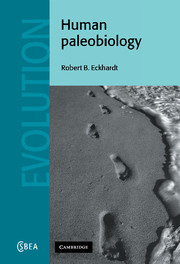Book contents
- Frontmatter
- Contents
- Preface
- Acknowledgments
- 1 Paleobiology: present perspectives on the past
- 2 Constancy and change: taxonomic uncertainty in a probabilistic world
- 3 A century of fossils
- 4 About a century of theory
- 5 Human adaptability present and past
- 6 Primate patterns of diversity and adaptation
- 7 Hominid phylogeny: morphological and molecular measures of diversity
- 8 Plio-Pleistocene hominids: the paleobiology of fragmented populations
- 9 Character state velocity in the emergence of more advanced hominids
- 10 The paleobiology of widely dispersed hominids
- 11 Paleobiological perspectives on modern human origins
- 12 A future for the past
- Bibliography
- Index
12 - A future for the past
Published online by Cambridge University Press: 18 December 2009
- Frontmatter
- Contents
- Preface
- Acknowledgments
- 1 Paleobiology: present perspectives on the past
- 2 Constancy and change: taxonomic uncertainty in a probabilistic world
- 3 A century of fossils
- 4 About a century of theory
- 5 Human adaptability present and past
- 6 Primate patterns of diversity and adaptation
- 7 Hominid phylogeny: morphological and molecular measures of diversity
- 8 Plio-Pleistocene hominids: the paleobiology of fragmented populations
- 9 Character state velocity in the emergence of more advanced hominids
- 10 The paleobiology of widely dispersed hominids
- 11 Paleobiological perspectives on modern human origins
- 12 A future for the past
- Bibliography
- Index
Summary
Limitations of the evidence
The challenge of human paleobiology is to reconstruct the appearances and lifeways of our ancestors over the course of several million years from evidence that is, in the epic epithet most often adopted by critics of the field, ‘sparse and fragmentary.’ The evidence is limited, and most specimens are far from complete. But this situation poses a challenge that is neither insurmountable nor even especially unique. Parallels are found in many other disciplines. In her history of England's Lollard religious movement, Anne Hudson (1988: 8) acknowledged what others had termed the ‘fragility and discontinuity of the existing evidence.’ She then went on to state her own philosophical stance, ‘evidence does not cease to be evidence because it is not ideal; the rider to this is that the obligation lies upon the researcher to refine or modify his techniques to accommodate the difficulties and obtain results if … the picture without new sources is manifestly inadequate. But on the other hand, the problems of the sources must be squarely faced and clearly explained; no useful purpose will be served by offering new evidence which appears to be firm and unambiguous when it is questionable, however much it may complete the perspective.’
It would be presumptuous as well as incorrect to characterize the existing state of human evolutionary studies that has been created by paleoanthropologists as ‘manifestly inadequate.’ My preference is to borrow a colleague's far more optimistic characterization of the field as ‘infinitely perfectible.’ In this sense, human paleobiology has come a long way, but it has much further to go.
- Type
- Chapter
- Information
- Human Paleobiology , pp. 280 - 293Publisher: Cambridge University PressPrint publication year: 2000

